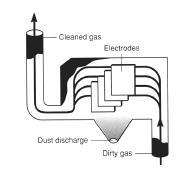|
This section contains 151 words (approx. 1 page at 300 words per page) |
A technique for removing particulate pollutants from waste gases prior to their exhaustion to a stack. A system of thin wires and parallel metal plates are charged by a high-voltage direct current (DC) with the wires negatively charged and the plates positively charged. As waste gases containing fine particulate pollutants (i.e., smoke particles, fly ash, etc.) are passed through this system, electrical charges are transferred from the wire to the particulates in the gases. The charged particulates are then attracted to the plates within the device, where they are then shaken off the plates during short intervals when the DC current is interrupted. (Stack gases can be shunted to a second parallel device during this period). They fall to a collection bin below the plates. Under optimum conditions, electrostatic precipitation is 99% efficient in removing particulates from waste gases.
 An electrostatic precipitator. (McGraw-Hill Inc. Reproduced by permission.)
An electrostatic precipitator. (McGraw-Hill Inc. Reproduced by permission.)
|
This section contains 151 words (approx. 1 page at 300 words per page) |


